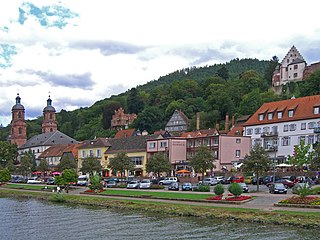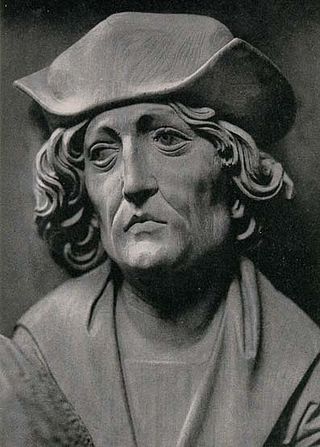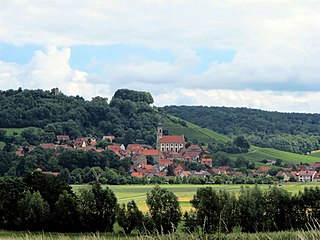
Melk is a city of Austria, in the federal state of Lower Austria, next to the Wachau valley along the Danube. Melk has a population of 5,257. It is best known as the site of a massive baroque Benedictine monastery named Melk Abbey.
Kitzingen is a Landkreis (district) in Bavaria, Germany. It is bounded by the districts of Schweinfurt, Bamberg, Neustadt (Aisch)-Bad Windsheim and Würzburg.

Miltenberg is a town in the Regierungsbezirk of Lower Franconia (Unterfranken) in Bavaria, Germany. It is the seat of the like-named district and has a population of over 9,000.

Tilman Riemenschneider was a German sculptor and woodcarver active in Würzburg from 1483. He was one of the most prolific and versatile sculptors of the transition period between late Gothic and Renaissance, a master in stone and limewood.

Marktbreit am Main is a town in the district of Kitzingen in the Regierungsbezirk Unterfranken in Bavaria, Germany. It is situated at the most southern point of the Main river. Marktbreit is the birthplace of Alois Alzheimer who first identified the symptoms of what is now known as Alzheimer's disease. With its suburb Gnodstadt, Marktbreit has around 3,700 inhabitants.

Kitzingen is a town in the German state of Bavaria, capital of the district Kitzingen. It is part of the Franconia geographical region and has around 21,000 inhabitants. Surrounded by vineyards, Kitzingen County is the largest wine producer in Bavaria. It is said to be Franconia's wine trade center.

Marienberg Fortress is a prominent landmark on the left bank of the Main river in Würzburg, in the Franconia region of Bavaria, Germany. The mighty Fortress Marienberg is a symbol of Würzburg and served as a home of the local prince-bishops for nearly five centuries. It has been a fort since ancient times. Most of the current structures originally were built in Renaissance and Baroque styles between the 16th and 18th centuries. After Gustavus Adolphus of Sweden conquered the area in 1631 during the Thirty Years' War, the castle was reconstructed as a Baroque residence. After it ceased to serve as residence of the Bishops of Würzburg, the fortress saw repeated action in the wars of the late 18th and 19th centuries. Festung Marienberg was severely damaged by British bombs in March 1945 and only fully rebuilt in 1990. Today, it houses two museums.

Rothenburg ob der Tauber is a town in the district of Ansbach of Mittelfranken, the Franconia region of Bavaria, Germany. It is well known for its well-preserved medieval old town, a destination for tourists from around the world. It is part of the popular Romantic Road through southern Germany. Today it is one of only three towns in Germany that still have completely intact city walls, the other two being Nördlingen and Dinkelsbühl, both also in Bavaria.

Buchbrunn is a municipality in the district of Kitzingen, Lower Franconia, Bavaria, Germany. It is placed in the Bayrische Planungsregion 2.

Ochsenfurt is a town in the district of Würzburg, in Bavaria, Germany. Ochsenfurt is located on the left bank of the River Main and has around 11,000 inhabitants. This makes it the largest town in Würzburg district.

Klingenberg am Main is a town in the Miltenberg district in the Regierungsbezirk of Lower Franconia (Unterfranken) in Bavaria, Germany. It has a population of around 6,200 and is located on both banks of the river Main.

Lohr am Main is a town in the Main-Spessart district in the Regierungsbezirk of Lower Franconia (Unterfranken) in Bavaria, Germany and the seat of the Verwaltungsgemeinschaft of Lohr am Main. It has a population of around 15,000.

Weinstadt is a town in the Rems-Murr district, in the state of Baden-Württemberg, Germany. It is located in the Rems Valley approximately 15 km east of Stuttgart. Its population in 2012 was 25,998.

Rothenfels is a town in the Main-Spessart district in the Regierungsbezirk of Lower Franconia (Unterfranken) in Bavaria, Germany and a member of the Verwaltungsgemeinschaft of Marktheidenfeld. With a population of just around 1,000 it is said to be Bavaria’s smallest town.

Seßlach is a town in the district of Coburg, in northern Bavaria, Germany. It is situated 12 km southwest of Coburg and has a population close to 4,000.

Castell is a municipality in the district of Kitzingen in Bavaria in Germany. It was the seat of the Counts of Castell. Today it is part of the municipal association Wiesentheid. It has around 800 inhabitants.

Franconia is a region for quality wine in Germany situated in the north west of Bavaria in the district of Franconia, and is the only wine region in the federal state of Bavaria. In 2014, vines were grown on 6,176 hectares of land in the region.

Würzburg is a city in the region of Franconia in the north of the German state of Bavaria. Würzburg is the administrative seat of the Regierungsbezirk Lower Franconia. It spans the banks of the Main River.

The Main Cycleway is a major German bicycle path running for about 600 km along the River Main in Germany. It starts from either Creußen or Bischofsgrün and ends in Mainz. The General German Bicycle Club (ADFC) rated the trail five stars in 2008, the first path in Germany to receive this award. Approximately 90% of the path is paved and 77% of the route is at least 2.5 metres wide.

The Marienkapelle is a Roman Catholic church located at the Unterer Markt of the town of Würzburg, Bavaria. It was built in the Gothic style in the 14th century. Despite its large size, it is a chapel by status, as it does not have a parish. Today it is administered by the united parishes of the Würzburg Cathedral and the Kollegiatstift Neumünster.



























